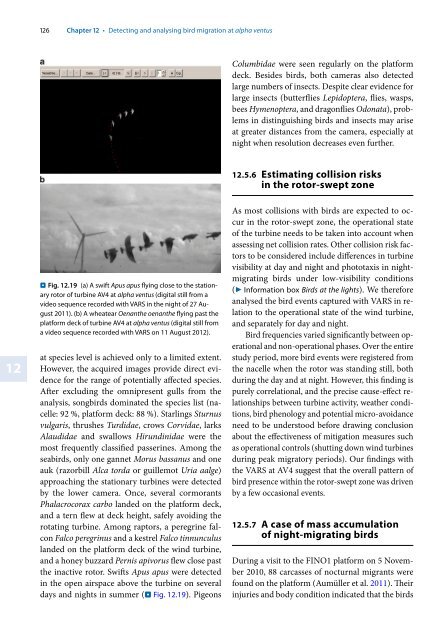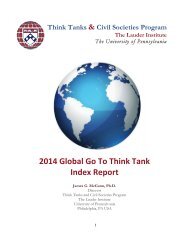bok%3A978-3-658-02462-8.pdf?auth66=1398409209_a0514c2b8e531c058ab8b810a0cad74d&ext=
bok%3A978-3-658-02462-8.pdf?auth66=1398409209_a0514c2b8e531c058ab8b810a0cad74d&ext=
bok%3A978-3-658-02462-8.pdf?auth66=1398409209_a0514c2b8e531c058ab8b810a0cad74d&ext=
- No tags were found...
You also want an ePaper? Increase the reach of your titles
YUMPU automatically turns print PDFs into web optimized ePapers that Google loves.
126Chapter 12 • Detecting and analysing bird migration at alpha ventus1234567891011121314151617181920..Fig. 12.19 (a) A swift Apus apus flying close to the stationaryrotor of turbine AV4 at alpha ventus (digital still from avideo sequence recorded with VARS in the night of 27 August2011). (b) A wheatear Oenanthe oenanthe flying past theplatform deck of turbine AV4 at alpha ventus (digital still froma video sequence recorded with VARS on 11 August 2012).at species level is achieved only to a limited extent.However, the acquired images provide direct evidencefor the range of potentially affected species.After excluding the omnipresent gulls from theanalysis, songbirds dominated the species list (nacelle:92 %, platform deck: 88 %). Starlings Sturnusvulgaris, thrushes Turdidae, crows Corvidae, larksAlaudidae and swallows Hirundinidae were themost frequently classified passerines. Among theseabirds, only one gannet Morus bassanus and oneauk (razorbill Alca torda or guillemot Uria aalge)approaching the stationary turbines were detectedby the lower camera. Once, several cormorantsPhalacrocorax carbo landed on the platform deck,and a tern flew at deck height, safely avoiding therotating turbine. Among raptors, a peregrine falconFalco peregrinus and a kestrel Falco tinnunculuslanded on the platform deck of the wind turbine,and a honey buzzard Pernis apivorus flew close pastthe inactive rotor. Swifts Apus apus were detectedin the open airspace above the turbine on severaldays and nights in summer (. Fig. 12.19). PigeonsColumbidae were seen regularly on the platformdeck. Besides birds, both cameras also detectedlarge numbers of insects. Despite clear evidence forlarge insects (butterflies Lepidoptera, flies, wasps,bees Hymenoptera, and dragonflies Odonata), problemsin distinguishing birds and insects may ariseat greater distances from the camera, especially atnight when resolution decreases even further.12.5.6 Estimating collision risksin the rotor-swept zoneAs most collisions with birds are expected to occurin the rotor-swept zone, the operational stateof the turbine needs to be taken into account whenassessing net collision rates. Other collision risk factorsto be considered include differences in turbinevisibility at day and night and phototaxis in nightmigratingbirds under low-visibility conditions(▶ Information box Birds at the lights). We thereforeanalysed the bird events captured with VARS in relationto the operational state of the wind turbine,and separately for day and night.Bird frequencies varied significantly between operationaland non-operational phases. Over the entirestudy period, more bird events were registered fromthe nacelle when the rotor was standing still, bothduring the day and at night. However, this finding ispurely correlational, and the precise cause-effect relationshipsbetween turbine activity, weather conditions,bird phenology and potential micro-avoidanceneed to be understood before drawing conclusionabout the effectiveness of mitigation measures suchas operational controls (shutting down wind turbinesduring peak migratory periods). Our findings withthe VARS at AV4 suggest that the overall pattern ofbird presence within the rotor-swept zone was drivenby a few occasional events.12.5.7 A case of mass accumulationof night-migrating birdsDuring a visit to the FINO1 platform on 5 November2010, 88 carcasses of nocturnal migrants werefound on the platform (Aumüller et al. 2011). Theirinjuries and body condition indicated that the birds




